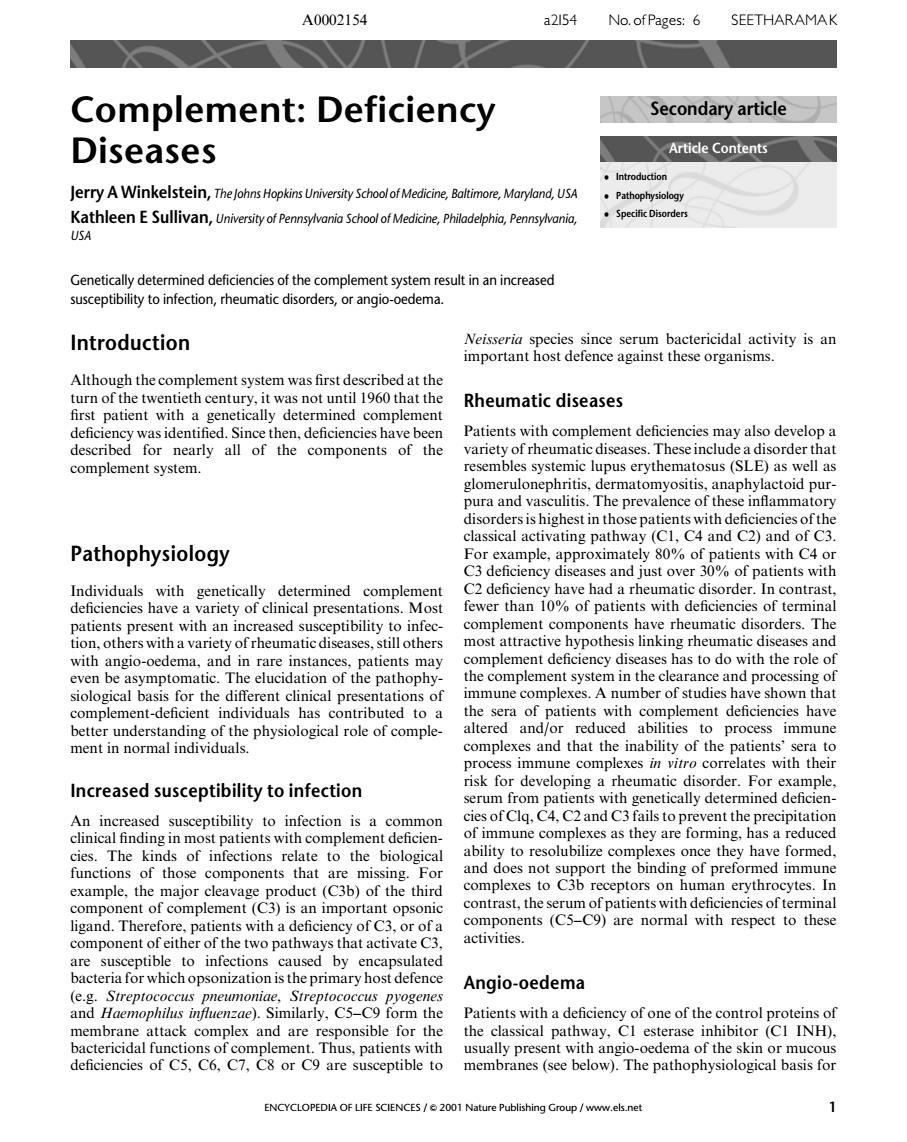正在加载图片...

A0002154 a2154 No.ofPages:6 SEETHARAMAK Complement:Deficiency Secondary article Diseases Artice Contents erry AWinkelstein,TheJohns Hopkins University Schoolof Medicine,Baltimore,Maryland,USA KathleeSullivan,nivPehidnd USA Genetically determined deficiencies of the complement system result in an increased susceptibility to infection,rheumatic disorders,or angio-oedema. Introduction Noisseria s pecies since serum bactericidal activity is an important host defence against these organisms. til 1960 that the first patient with a genetically determined complment Rheumatic diseases Patients with complement deficiencies may also de ses complement system glomerulonephritis,dermatomyositis.anaphylactoid pur pura and vasculitis.The prevalence of these inflammatory and Pathophysiology C2)n Cdeficiency diseases and just over0%of patients with Individuals with genetically determined complemen C2 deficiency have had a rheumatic disorder.In contrast deficiencies have a variety of clinical presentations.Most fewer than 10%of patients with deficiencies of termina aiedpibtione nd in complement deficiency diseases has to do with the role of even be asymptomatic.The clucidation of the pathophy siological basis for the different clinical presentations of mune comple A number ha ent in lividuals has contributed to ephysiologicalroteotCompke orocess immune complexes in vitro correlates with their Increased susceptibility to infection risk for devel srder.For example. 、f1 of immune complexes as they are forming.has a reduced ies.The mple ability to resolubilize complexes once they have formed, binding of preform ned immune example,the major cleavage product(C3b)of the third nts with component of complement (C3)is an important opsonic ligand components (C5-C9)are normal with respect to these activities. caused hy bacteria for which opsonization is the primary host defence Angio-oedema are Thus.paticn with nt with angi oedema of the skin or muco deficiencies of C5,C6.C7,C8 or C9 are susceptible to membranes(see below).The pathophysiological basis for ENCYCLOPEDIA OF LIFE SCIENCES/ ublishing Group/www.els.netComplement: Deficiency Diseases Jerry A Winkelstein, The Johns Hopkins University School of Medicine, Baltimore, Maryland, USA Kathleen E Sullivan, University of Pennsylvania School of Medicine, Philadelphia, Pennsylvania, USA Genetically determined deficiencies of the complement system result in an increased susceptibility to infection, rheumatic disorders, or angio-oedema. Introduction Although the complement system was first described at the turn of the twentieth century, it was not until 1960 that the first patient with a genetically determined complement deficiency was identified. Since then, deficiencies have been described for nearly all of the components of the complement system. Pathophysiology Individuals with genetically determined complement deficiencies have a variety of clinical presentations. Most patients present with an increased susceptibility to infection, others with a variety of rheumatic diseases, still others with angio-oedema, and in rare instances, patients may even be asymptomatic. The elucidation of the pathophysiological basis for the different clinical presentations of complement-deficient individuals has contributed to a better understanding of the physiological role of complement in normal individuals. Increased susceptibility to infection An increased susceptibility to infection is a common clinical finding in most patients with complement deficiencies. The kinds of infections relate to the biological functions of those components that are missing. For example, the major cleavage product (C3b) of the third component of complement (C3) is an important opsonic ligand. Therefore, patients with a deficiency of C3, or of a component of either of the two pathways that activate C3, are susceptible to infections caused by encapsulated bacteria for which opsonization is the primary host defence (e.g. Streptococcus pneumoniae, Streptococcus pyogenes and Haemophilus influenzae). Similarly, C5–C9 form the membrane attack complex and are responsible for the bactericidal functions of complement. Thus, patients with deficiencies of C5, C6, C7, C8 or C9 are susceptible to Neisseria species since serum bactericidal activity is an important host defence against these organisms. Rheumatic diseases Patients with complement deficiencies may also develop a variety of rheumatic diseases. These include a disorder that resembles systemic lupus erythematosus (SLE) as well as glomerulonephritis, dermatomyositis, anaphylactoid purpura and vasculitis. The prevalence of these inflammatory disorders is highest in those patients with deficiencies of the classical activating pathway (C1, C4 and C2) and of C3. For example, approximately 80% of patients with C4 or C3 deficiency diseases and just over 30% of patients with C2 deficiency have had a rheumatic disorder. In contrast, fewer than 10% of patients with deficiencies of terminal complement components have rheumatic disorders. The most attractive hypothesis linking rheumatic diseases and complement deficiency diseases has to do with the role of the complement system in the clearance and processing of immune complexes. A number of studies have shown that the sera of patients with complement deficiencies have altered and/or reduced abilities to process immune complexes and that the inability of the patients’ sera to process immune complexes in vitro correlates with their risk for developing a rheumatic disorder. For example, serum from patients with genetically determined deficiencies of Clq, C4, C2 and C3 fails to prevent the precipitation of immune complexes as they are forming, has a reduced ability to resolubilize complexes once they have formed, and does not support the binding of preformed immune complexes to C3b receptors on human erythrocytes. In contrast, the serum of patients with deficiencies of terminal components (C5–C9) are normal with respect to these activities. Angio-oedema Patients with a deficiency of one of the control proteins of the classical pathway, C1 esterase inhibitor (C1 INH), usually present with angio-oedema of the skin or mucous membranes (see below). The pathophysiological basis for a2154 No. of Pages: 6 SEETHARAMAK Article Contents Secondary article . Introduction . Pathophysiology . Specific Disorders A0002154 ENCYCLOPEDIA OF LIFE SCIENCES / & 2001 Nature Publishing Group / www.els.net 1